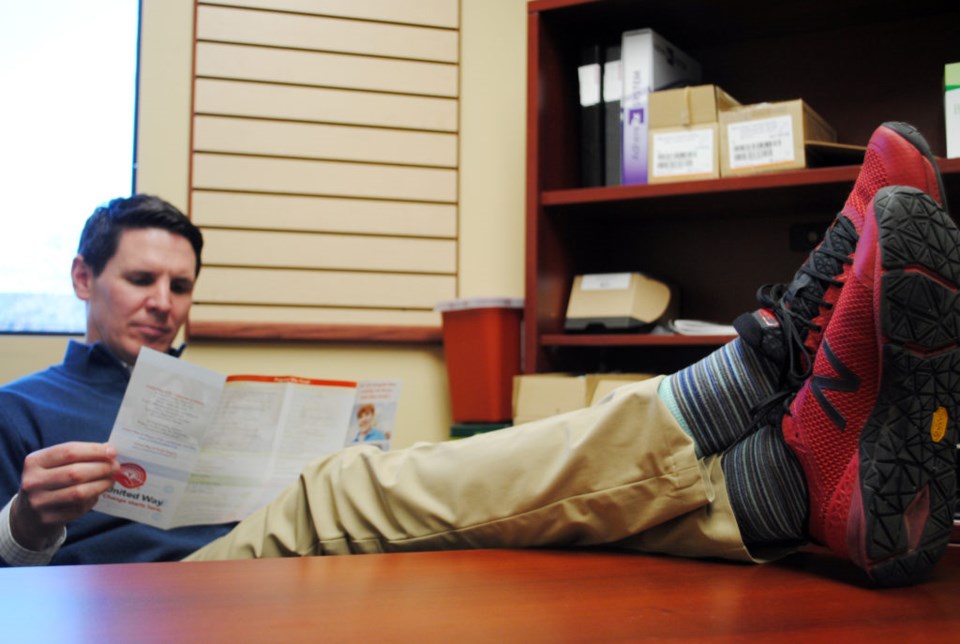
When Sean Simpson announces the success of the United Way of Niagara’s first fundraising campaign, he’ll be doing so with no small personal relief, having committed to wearing a certain pair of red sneakers until the goal was met.
“We will be announcing the fact that we surpassed our $5 million goal,” says the pharmacy owner, who was planning to share his good news with the public Thursday.
The shoes as a branding exercise began as an accident, Simpson explains.
“The campaign theme was ‘Hit the Ground Running,’ and I happened to wear red sneakers to the launch,” he says. “It was a good excuse to wear them throughout the campaign, a good reminder for me that we had a goal to meet.”
They also served as an opportunity to raise awareness, as a conversation piece.
“At a meeting in Vancouver, and at an event in Toronto, I was quickly able to explain the red sneakers and draw attention to the campaign.”
However, “There were a few cold days in December and January when I would have liked to have been wearing more robust footwear,” he adds.
The United Way of Niagara is a new entity, having been recently created through the merger of three smaller agencies: the United Ways of Niagara Falls, Greater Fort Erie, and South Niagara. Simpson is on the transitioning committee.
“There were effectively three United Ways competing in a small region where people often live and work in different jurisdictions,” says the local businessman known for his family’s legacy of philanthropy. “There were three boards of 12 volunteers each — the capacity of the total system is enhanced by moving forward as one organization.”
With three separate United Ways, he says, “some agencies were forced to write three different funding applications — for example the Canadian Mental Health Association. This is a drain on resources, given that a lot of staff are writing grant and funding applications.”
“We were simply trying to find levels of efficiencies, looking for reductions in cost wherever possible — these are always priorities with a charitable organization,” he explains.
While one in three people in Niagara is touched by the United Way, says Simpson, who has been on various boards of the agency for more than six years, “a good number of people don’t know what the United Way does.”
“It is critical to understand that all funds stay within the region: United Way Niagara serves all people in Niagara,” he adds. “What I like about the United Way is that, with so many great charities around, this is a way to support over 100 programs run by over 70 agencies, with the money going to those who can use it the most,” he says. “Volunteers do a really good job of determining where the money can have the greatest impact.”
Simpson describes just a few of the programs supported by the charity. “One of the most successful is an after-school program in at-risk neighbourhoods, keeping kids engaged and off the streets,” he says.
“Another project is filling backpacks. We get great support with getting bags and supplies, for families who have a hard time preparing their kids for school. There is also the Niagara Nutrition program, which supplies breakfast and healthy snacks for kids who need them.”
Fundraising happens in a number of ways, but the mainstay is automatic deductions at work. “When I graduated from pharmacy school, I started to give to the United Way through our workplace campaign,” recalls Simpson. “It didn’t cost a lot, just $1 to $2 per pay cheque.”
Now the employer of a number of people, Simpson continues to offer the workplace donation campaign to his staff, and suggests other businesses consider doing the same.
With the economy’s move away from larger workplaces — GM, for example — Simpson says the fundraising focus is turning to smaller businesses, as well as independent giving. But he cites local businesses such as Vintage Inns, the Town, and Robin Ridesic of The Exchange Brewery as workplace supporters of the United Way.
Simpson is quick to point out donations don’t have to be monetary. “You can give dollars, you can give time, you can give experience,” he says.
And while a new campaign chair will be announced at the event, along with the outcome of the campaign, he says, “My work with the United Way has been very rewarding.”